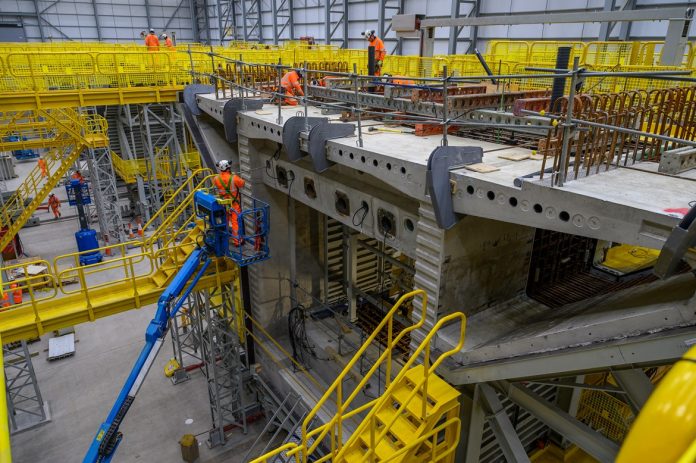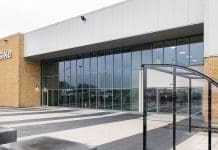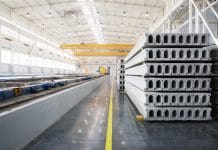HS2 began production of 1,000 huge concrete segments this week as the construction effort intensifies on the UK’s longest railway bridge
Work on the UK’s longest railway bridge was ramped up this week as HS2 began producing the enormous concrete segments that will form the deck of the Colne Valley Viaduct.
The viaduct will form part of the HS2 project and carry high-speed trains for 2.1 miles (3.4km) across a series of lakes and waterways just outside London.
It has been designed to improve rail links between London, Birmingham and North whilst boosting the economy and providing a low carbon alternative to car and air travel.
The enormous deck segments weighing up to 140 tonnes. Currently, they are being produced at a temporary factory built specifically for the HS2 railway bridge project.
The new factory is also huge – stretching 100m and with an internal volume of105,000 cubic metres it is larger than the Royal Albert Hall. The facility can be seen from the M25.
‘This iconic structure will carry trains at up to 200mph’
HS2 project client, David Emms commented:
“We’re already making strong progress on the Colne Valley Viaduct – sinking the foundations, building the first piers, and now starting production at the new modular viaduct factory.
“Once complete, this iconic structure will carry trains at up to 200mph – improving connections across the UK, freeing up rail capacity and offering passengers low carbon travel options.
“It’s great to see how much progress has been made and I look forward to seeing work on assembling the deck structure later this year.”
The segments
Engineers from HS2’s main works contractor Align JV are leading the project to build the UK’s longest railway bridge.
The individual segments will also be shaped slightly differently so that they can fit exactly into the viaduct. A modular approach to construction will ensure the high quality, safety and efficiency of the production and avoid the need to transport them via road.
The 12 segments – each the size of a double-decker bus – will be cast every week using a ‘match-casting’ technique. This means that each segment is will be poured against the previous one so that the whole arch will fit perfectly when reassembled on site.
Upon completion, the factory and surrounding buildings will be removed and the whole area will be transformed into an area of chalk grassland and woodland as part of HS2’s ‘green corridor’ project.
Daniel Altier, Align project director added:
“Seeing the first deck segments being cast in the factory marks a significant milestone for the project. The design of the viaduct is such that each segment will be unique, delivering a structure which I have no doubt will be one of the most striking elements of HS2 once complete.
“I would like to thank all the Align team and our supply chain partners that have enabled us to get to where we are today and in particular VSL, Danny Sullivan, Sendin and Tarmac.”
Design
The Colne Valley Viaduct was inspired by the flight of a stone skipping across the water.
Se low into the landscape, a series of elegant spans, some up to 80m long, will carry the railway across the surface of the lakes, the River Colne and the Grand Union Canal.
Wider spans will carry the UK’s longest railway bridge across the lakes, with narrower spans for the approaches.
This design will enable brilliant views across the surrounding landscape whilst minimising the viaduct’s footprint on the lakes.
The piers
56 giant peers must support the viaduct and so work is already underway on the construction of them, alongside the segments.
The piers must support the full weight of what will be the UK’s longest railway bridge and so it comes as no surprise that each individual pier weighs roughly 370 tonnes.
The first of these piers was cast on site using a specially-designed formwork to create the shape of the structure. This was then removed after 4 days to reveal the final product.
Once completed each pier will rest on a set of concrete piles going up to 55m into the ground. This foundation work is already underway and will require the construction of 292 piles and 56 pile caps across the whole length of the viaduct.
Once the foundations have been completed, the HS2 team will then use a specialised ‘launching girder’ resting on top of the piers to lift the deck segments into position.
There is progress in other areas of the project – for example, the the first two of four jetties have been completed.




![[VIDEO] HS2 completes 4,600-tonne viaduct slide across M6 The HS2 team completed a 17-hour long operation sliding the viaduct structure across the M6 without closing the motorway](https://www.pbctoday.co.uk/news/wp-content/uploads/2025/12/M6-South-viaduct-slide-taking-place-across-a-live-motorway-December-2025-218x150.jpg)


![[Video] Enhancing safety with fire doors: A case study of Marina Care Home](https://www.pbctoday.co.uk/news/wp-content/uploads/2025/06/maxresdefault-218x150.jpg)

![[VIDEO] Heathrow’s third runway plan wins out over Arora London, United Kingdom – May 31, 2023: A commercial airliner taking off at London's Heathrow Airport, representing plans for a third runway](https://www.pbctoday.co.uk/news/wp-content/uploads/2025/11/iStock-2143084103-218x150.jpg)




![[VIDEO] Making DorTrak reports easy to read with Fireco Inspecting fire doors at Fireco, firedoor technology, 2023](https://www.pbctoday.co.uk/news/wp-content/uploads/2024/04/JPZ_2364-web-218x150.jpg)